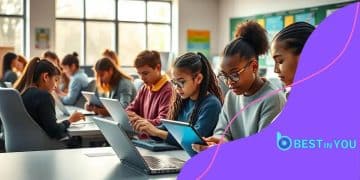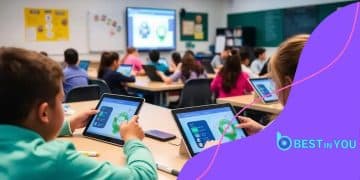How gamified learning apps are reshaping homework habits

Gamified learning apps are reshaping homework habits by making studying engaging and motivational through game-like features, enhancing student participation and ownership in the learning process.
How gamified learning apps are reshaping homework habits. Have you ever wondered why some students seem to enjoy studying more than others? Gamified learning apps could hold the answer! These innovative tools are not just reshaping how homework gets done; they are making the entire learning process more engaging and fun.
Understanding gamified learning: What is it?
Understanding gamified learning is the first step to realizing its potential in educational practices. At its core, gamified learning integrates game mechanics into the educational process to enhance engagement and motivation. This approach taps into the natural enjoyment people find in games, transforming learning tasks into fun challenges.
The elements of gamified learning often include point systems, levels, and rewards. These elements drive students to complete their assignments, making homework feel less like a chore and more like an engaging game. It’s fascinating how just by adding competition or a reward system, students become more excited about their studies.
Why gamification works
One reason gamified learning is so effective is that it creates a sense of achievement. When students earn points or badges for completing tasks, they receive instant feedback. This feedback is crucial in motivating learners, as it encourages them to strive for improvement.
- Points systems promote healthy competition among peers.
- Levels provide a clear progression, showing students how far they’ve come.
- Rewards keep students engaged and eager to learn more.
Additionally, gamified learning caters to various learning styles. Some students respond best to visual stimuli, while others learn through interaction. By incorporating gaming elements, educators can create a more inclusive environment that meets diverse needs.
Examples of gamified learning applications
There are numerous applications and platforms that illustrate gamified learning in action. For instance, platforms like Kahoot! allow teachers to create quizzes that turn learning into a lively game. Similarly, Duolingo gamifies language learning with a fun point system that encourages daily practice.
Through these tools, students not only learn content but also develop critical thinking and problem-solving skills. This method engages them actively rather than passively receiving information. Ultimately, when students are having fun, they are likely to retain information better and develop a positive attitude toward learning. Thus, gamified learning not only changes how homework is approached but also reshapes the entire educational experience into something more dynamic and appealing.
The impact of gamified apps on student engagement
The impact of gamified apps on student engagement cannot be overlooked. These apps are designed to make learning more interactive and enjoyable. By transforming traditional studying into gaming experiences, students often find themselves more motivated to participate.
One major factor contributing to this increased engagement is the sense of achievement. With point systems and rewards, students feel a rush when they complete tasks successfully. This positive reinforcement keeps them coming back to learn more. Research has shown that this kind of engagement can lead to better retention of information, as students remember concepts they enjoyed learning.
Key benefits of gamified apps
There are several key benefits of using gamified learning apps in the classroom:
- Improved motivation: Students are more likely to engage with subjects that are presented in a fun way.
- Active participation: Gamification encourages students to take an active role in their learning.
- Personalized learning: Apps can adapt to each student’s level, providing tailored challenges.
This personalized approach ensures that students are not left behind, as they can progress at their own pace. Furthermore, the collaborative nature of many gamified apps fosters teamwork and communication among peers. For instance, students can work together to solve puzzles or compete in quizzes, building social skills while learning.
Examples showing increased engagement
Many educators have noticed a significant increase in engagement when using gamified approaches. For example, platforms like Classcraft immerse students in role-playing scenarios where they earn points for good behavior or completing assignments. This kind of teamwork and roleplay not only makes learning enjoyable but also strengthens class dynamics.
Overall, the evidence is clear: gamified apps have a profound effect on student engagement. They turn mundane tasks into exciting challenges, keeping students interested and invested in their learning process. By incorporating these apps into education, teachers can tap into students’ innate desire for competition and achievement, creating an enriched learning environment.
How these apps promote better homework habits

How these apps promote better homework habits is a crucial topic in modern education. Gamified learning apps have a unique way of encouraging students to complete their assignments. They make the homework experience less daunting by incorporating game-like features that boost motivation.
One of the primary ways these apps promote better habits is by turning assignments into engaging challenges. Instead of viewing homework as a chore, students perceive it as a fun activity. This shift in mindset is vital. When students enjoy their tasks, they are more likely to stay committed and finish their work.
Features that encourage consistent study
Several features of gamified apps help develop better homework habits:
- Point systems reward students for completing tasks.
- Levels and stages provide clear goals and milestones.
- Reminders and deadlines keep students organized and on track.
These features work together to create a structured learning environment. When students see the rewards stacking up, they become eager to achieve their next milestone. This makes them keen to stay engaged with their studies, fostering a habit of regular homework completion.
Building accountability and ownership
An important aspect of gamified learning is the sense of accountability it generates. Students take ownership of their progress. They can track their achievements and see the results of their efforts. This important factor leads to improved self-discipline, as students learn to manage their time effectively.
Moreover, some apps include features that allow for collaborative tasks. When students work together on challenges, they not only motivate each other but also build teamwork skills. This social interaction can deeply enhance their learning experience. By supporting one another, students are more likely to develop positive homework habits that extend beyond the classroom.
Overall, gamified learning apps play a vital role in promoting better homework habits through engagement, accountability, and collaboration. They transform the traditional view of homework, making it a key part of an enjoyable educational journey.
Case studies: Success stories in gamified learning
Case studies provide valuable insights into how gamified learning can transform educational experiences. Across various settings, schools and educators have successfully implemented these innovative apps to enhance engagement and improve learning outcomes. Let’s explore a few success stories that highlight the effectiveness of gamification in education.
One notable example is a middle school in California that integrated a gamified learning platform into its curriculum. Teachers noticed a remarkable increase in student participation and enthusiasm. Students engaged with the material through game-like challenges, earning points and badges for completing assignments. As a result, homework completion rates improved significantly, demonstrating the positive impact of gamified apps.
Example 1: A school district’s approach
In a school district in Texas, educators adopted a popular gamified app for math lessons. The app featured interactive quizzes and engaging exercises. Students worked at their own pace, earning rewards for mastering concepts. The district saw a 30% increase in math scores over the school year. The success encouraged more teachers to explore gamified methods in their classrooms.
- Improved student performance in math.
- Increased engagement through interactive challenges.
- Positive feedback from both students and parents.
Another strong case comes from an urban high school where teachers introduced a gamified platform for science education. Visible changes occurred as students collaborated in groups to complete virtual missions. This approach not only fostered teamwork but also deepened their understanding of complex concepts. Students reported enjoying the lessons more and felt more connected to their peers.
Example 2: Enhancing language learning
A language learning app implemented in an international school showcases another success story. Students competed against one another in language games while earning rewards for their progress. This friendly competition encouraged students to practice regularly. The school’s language proficiency rates improved, and students found themselves excited about learning new vocabulary and grammar structures.
These case studies clearly demonstrate the effectiveness of gamified learning. By incorporating game elements into educational practices, students can thrive in a more interactive, enjoyable environment. As more schools adopt these innovative techniques, the trend toward gamified learning is only expected to grow, reshaping how students engage with their education.
Tips for integrating gamified apps into daily study routines
Integrating gamified apps into daily study routines can significantly enhance a student’s learning experience. To make the most of these innovative tools, it’s essential to use them effectively. Here are some practical tips that can help in this integration.
First, set clear goals for what you want to achieve with the gamified app. Define specific learning objectives. Whether it is mastering a math concept or expanding vocabulary, having a goal will give your study sessions focus. This will help students measure their progress and stay motivated.
Creating a schedule
Create a consistent study schedule that includes time for using gamified apps. Incorporating these apps at the same time every day reinforces the habit. For example, pairing the app usage with regular homework time can create a productive routine. This consistency will make it easier for students to engage with the learning material regularly.
- Use apps as a reward after completing traditional homework.
- Stay consistent with time slots to build routines.
- Mix different types of apps for varied learning experiences.
Additionally, involve peers in the learning process. Many gamified apps encourage collaboration, so consider studying with friends. This can create a social aspect to learning, making it more enjoyable. Working together through challenges can foster teamwork and enhance understanding of the subject matter.
Incorporating feedback
Another effective strategy is to utilize the feedback provided by these apps. Most gamified apps offer real-time feedback, which is helpful for students to identify areas that need improvement. Encourage students to review their performance and adjust their study strategies accordingly. This proactive approach will help them take ownership of their learning.
Finally, keep track of progress. Many gamified apps provide analytics and reports on performance, allowing students to visualize their learning journey. Celebrating achievements, such as reaching a new level or earning a badge, boosts motivation and reinforces positive study habits. By being aware of their successes, students are more likely to stay committed to their study routines.
In summary, by establishing goals, creating a schedule, involving peers, utilizing feedback, and tracking progress, students can maximally integrate gamified apps into their daily study routines. These strategies make studying more engaging and effective, ultimately leading to better learning outcomes.
FAQ – Questions about Gamified Learning Apps
How do gamified learning apps improve student engagement?
Gamified learning apps improve engagement by turning traditional studying into fun, interactive challenges that motivate students to participate actively.
Can these apps help with time management for homework?
Yes, many gamified apps include features like reminders and progress tracking, which help students manage their homework time more effectively.
What are some examples of gamified apps used in classrooms?
Examples include Kahoot!, Classcraft, and Duolingo, which use game elements to encourage learning in subjects like math, science, and languages.
How can I integrate gamified apps into my study routine?
You can set specific goals, create a consistent schedule for using the apps, involve peers in collaborative tasks, and track your progress for motivation.






